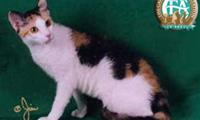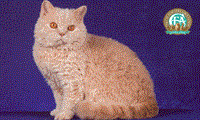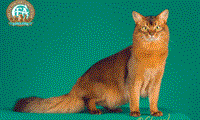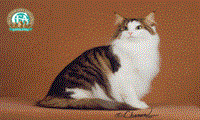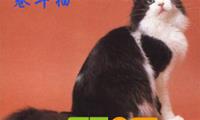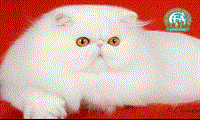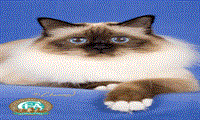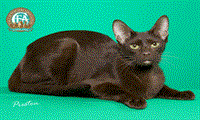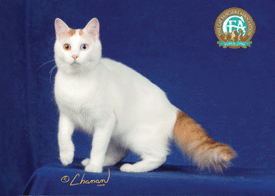
美國CFA官方關於土耳其梵貓的品種簡介的中文翻譯版本和英文原文。
土耳其梵貓的起源:17世紀
四肢中等長度,
土耳其梵貓的頭:中到大型。 長至少和寬相等。 圓弧線條。 沒有棱角, 沒有直線條。 顴骨高。 吻部豐滿而渾圓。 微有鼻終止, 鼻尖帶精緻的鷹鉤。 吻部和臉頰分界頗明顯。 下巴略圓潤。
土耳其梵貓的耳:大, 基部寬, 位置高, 耳尖略圓。
土耳其梵貓的眼:大, 栗子形或核桃形, 眼梢微微吊起。 眼皮以粉紅色強調。 顏色:藍色, 琥珀色或不同色的。 綠色也可以接受, 但琥珀色為佳。
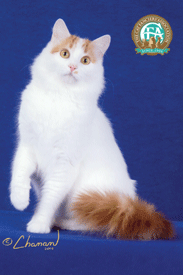
土耳其梵貓的頸:短而粗壯。
土耳其梵貓的身體:長, 大型, 強壯。 肋骨圍成的胸腔渾圓。 臀部頗寬。 骨架大, 肌肉發達。
土耳其梵貓的腿和爪:適度長。 後腿比前腿長。 骨骼中等大小, 肌肉發達。 爪呈圓形。 趾間毛髮濃密。
土耳其梵貓的尾:適度長, 粗, 覆蓋被毛濃密, 呈長絨毛狀。 至少長5釐米。 整個尾部的顏色均勻分佈。
土耳其梵貓的被毛:半長到長, 柔軟, 絲質, 沒有羊毛狀的底層絨毛。 冬季領圈毛和褲子毛髮豐厚。 純白色被毛, 紅棕色或奶油色對稱斑紋。 耳基部由白色火焰紋分隔開來。 這種排列方式的斑紋稱為“凡湖”圖案。
注釋:沒有允許雜交品種可接受的顏色如下:
乳黃色貓(乳黃色斑紋與白色粉筆似的被毛形成對比。 面部垂直向下的白色面斑一直伸過鼻子, 把頭上顏色區分成兩半。 頭上顏色區局限於眼睛以上, 不能伸過耳後跟。 耳朵本身是白色, 耳內是帶淡黃色的粉紅色。 尾巴應是純乳黃色並可能略向上延伸至背部。 )
紅褐色貓(斑紋圖案非常重要, 頭上的紅褐色毛區局限於眼睛以上且不能延伸至耳後。 鼻子是白色, 清晰的垂直白色面斑把頭上紅褐色區分成兩半, 尾巴也是紅褐色。 )
不良性徵:身體出現多於三個的斑塊。 臉部沒有火焰紋。 斑紋分佈不均勻。
特徵:特別的頑強, 環境忍受能力好, 非常活潑, 愛游泳。 儘管曾經被人認為具有攻擊性, 現在經過育種專家的努力, 該品種的行為已經變得很友好, 對其他貓尤其如此。 獨立個性, 貪玩, 個性強, 感情豐富, 常常對主人表現出佔有欲。 是非常好的伴侶, 嗓門略大。 能適應公寓生活。 但有水環境的大型庭院更佳。 生長遲緩, 要3到5年時間才能完全成年。 平時每週一次的毛髮梳理即可, 夏初脫毛季節需要適度增加次數。

CFA官方關於土耳其梵貓的品種簡介的英文原文:
Breed Profile: Turkish Van
The cat known in the United States as the Turkish Van is a rare and ancient breed that developed in central and southwest Asia, which today encompasses the countries of Iran, Iraq, southwest Soviet Union and eastern Turkey. “Van” is a common term in the region that has been given to a number of towns, villages and even a lake - Lake Van - so it is no surprise that the uniquely patterned cat native to the region was named the “Vancat” by the residents. They were first brought to England in 1955 as the Turkish cats, but this was later changed to Turkish Van to avoid confusion with the Turkish Angora. Although the breed has an ancient lineage, the Turkish Van is a relative newcomer to the United States, arriving in 1982. They are considered regional treasures in their homeland, and are not readily available for export to other countries. Even in areas where the breed has been known for centuries, they are still relatively rare.
The breed was first brought into Europe from the Middle East by returning crusaders, and has been known by a variety of names over the centuries such as the white ringtail and the Russian longhair. A common misconception is that the Turkish Van is simply a color variation of the better known Turkish Angora. In reality, the Van and the Angora are distinct breeds that developed in geographically distant regions of Turkey. When seen together, the differences in type, size, boning and coat are readily apparent.
The coloration of the Turkish Van, which is considered by many to be the original breed to carry the piebald gene, calls for a white, semi-longhaired cat with colored markings restricted primarily to the head and tail. Other piebald cats that have been selectively bred for many generations to achieve similar markings are said to be “van-patterned” after the breed that originally sported it. The coat lacks an undercoat and has a very unique cashmere-like texture that makes it water-resistant. This brings us to another interesting feature of this breed - they love water and in their native region they have been termed “the Swimming Cats.”
The Turkish Van takes three to five years to reach full maturity and is a large and agile cat of substantial strength. They are very intelligence as well as curious and make very rewarding companions in the right home. The breed is a healthy one and the unique coat does not lend itself to matting, so they require little grooming.
Pricing on Turkish Vans usually depends on type, applicable markings and bloodlines distinguished by Grand Champion (GC), National or Regional winning parentage (NW or RW) or of Distinguished Merit parentage (DM). The DM title is achieved by the dam (mother) having produced five CFA grand champion/premier (alter) or DM offspring, or sire (father) having produced fifteen CFA grand champion/premier or DM offspring. Usually breeders make kittens available between twelve and sixteen weeks of age. After twelve weeks, kittens have had their basic inoculations and developed the physical and social stability needed for a new environment, showing, or being transported by air. Keeping such a rare treasure indoors, neutering or spaying and providing acceptable surfaces (e.g. scratching posts) for the natural behavior of scratching (CFA disapproves of declawing or tendonectomy surgery) are essential elements for maintaining a healthy, long and joyful life.
There are CFA clubs devoted to the promotion, protection and preservation of the Turkish Van breed. For more information, please send inquiries to CFA, PO Box 1005, Manasquan NJ 08736-0805.
